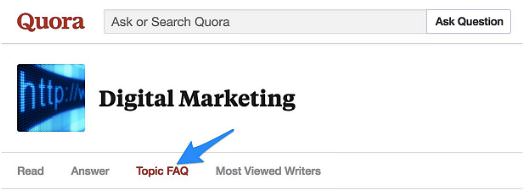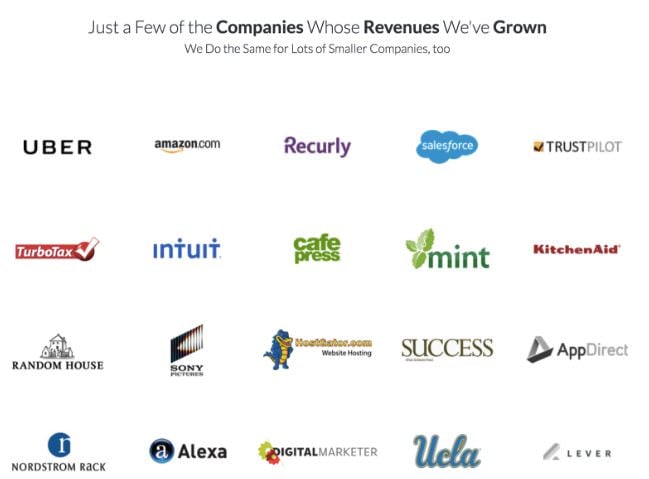Effective copywriting is all about building trust with your audience, understanding their needs and then convincing them that your solution can alleviate their pain most efficiently.
Before you can sell them anything, you need to build a strong foundation of trust. Once you have that relationship, it becomes much easier to sell someone.
Think about it, are you more likely to buy something because your friend recommended it or because a random review on Amazon said “OMG BEST THING EVER. YOU MUST GET ONE! 5 stars!!!!”
When you ask someone to buy something, you’re asking them to take a chance. The chance that they are going to make an investment that doesn’t end up being worth the cost. Obviously, the main goal of your copy from the top of the funnel all the way to the bottom is to demonstrate that your offer is 100% worth the investment. And you can see how that starts with trust.
Not only is someone more likely to buy from you if they trust you, but they are more likely to value your time and insight. This often leads to much lower price sensitivity. If your competitor is out there charging 20% less, but they already trust you, that savings might not matter.
It goes back to the risk associated with buying something new (especially online). They have a choice: take a chance on the cheaper option, but risk wasting their time and money or pay you a bit more with more certainty that they will get the results they’re seeking.
Here’s how you can start building trust with your audience today…
Know Your Audience
If you want readers (or viewers) to trust you, then you need to genuinely understand where they are coming from and connect with that. There’s a simple 3-step process to establishing this understanding.
1) Develop customer profiles
Set aside some time to really ask yourself who you are trying to connect with. If your product targets multiple demographics, outline them each separately. This is very important as two demographics might buy the same product for different reasons. And when you’re establishing trust, it’s essential that you convey your understanding of those reasons.
2) Identify their pain points
Once you have outline who your target customers are, find out their pain points. Know their questions and concerns. There are lots of ways to do this. Start by searching Quora’s Topic FAQ and industry sub-Reddits to see what people are talking about.

Are they struggling with anything in particular, what are the problems with existing solutions, what makes a great solution, what are people struggling to understand that you can help with?
If you have an email list of prospective and existing customers, you should also leverage that. Ask them to take 2-minutes to email you their questions, stories, and dreams. This helps build trust in two layers.
On one hand, you get a goldmine of market research. You know exactly what buyers are looking for. On the other, you’re inviting readers to engage with you in a dialogue. You’re crafting content and products around their personalized needs. They will see that you care and value that greatly.
3) Alleviate their problems and concerns with your expertise
Once you’ve identified what the market needs, connect your product to those needs. What are the benefits of your product? What knowledge or experience do you have that can help them? We’ll talk more about this in a minute, but it’s important that you directly answer the concerns in step two at every step.
Write Like You Speak
Whether you’re writing content for your blog, email sales copy, or a video script, it’s important to keep things personable. Even in formal industries like aerospace engineering and legal services, it’s important to appear human. Remember, the key is to start a dialogue with your reader.
While this one is pretty self-explanatory, there are a few hacks you can use to make sure that you are always keeping things conversational.
1) Write in the first person
Writing in the first person invites the reader to get to know you. When I talk about my personal experience marketing for different companies, I stop being a faceless blog writer and become someone you can trust. You get a taste of my unique personality and that helps you start a different kind of relationship with me.
2) Break grammar rules intentionally
Be honest. When you speak, do you ever start a sentence with “but” or “and”? Do you use sentence fragments? Or are you always careful to make sure that every sentence that comes out of your mouth is perfect?
Now, you shouldn’t write sloppy or incoherent. You can’t sound lazy or uneducated. But if it feels natural to end that sentence with a preposition then, by all means, go on. (okay, I may have put a little effort into that one…)
I can take that a step further when I start talking about “us.” When I say things like “now we can start increasing your conversions,” I’m implying that relationship. I’m not telling you to go and work on this project alone. I’m asking you to do it with me. Together, we can overcome your challenges.
3) Write as quickly as possible. Fix it, edit later.
When you first start writing any type of copy, just get your thoughts down. You should definitely set up an outline first, but when you sit down to write, just write. It won’t be perfect, and that’s okay. In fact, the best copywriters throw out more than half of their first draft.
While this sounds time-consuming, it’s not. Without stopping to stress over word choice and grammar, you can get a lot of natural sounding content down quickly. Then go back and clean it up to make sure it’s coherent.
But the key benefit here is you’ll sound more natural if you write as it flows from your brain.
4) Avoid big words and jargon
If there’s one thing we can all learn from the 2016 US elections it’s the effectiveness of Trump’s common language. Regardless of your political beliefs, you can tell that people connected with him because he spoke in an accessible manner.
Some people try to impress others with sophisticated vocabulary or technical jargon. While it can have its place in limited quantities to help establish your authority, you should keep it light.
Readers should understand everything you’re saying without having to run to Google. If they need another resource to understand what you’re saying, you’re not doing your job.
Establish Yourself As An Authority
People inherently trust authority. You may recall the famous Milgram Experiment that showed simply wearing a lab coat was enough to convince the majority of people to administer supposedly lethal dosages of electricity to strangers.
Now, I’m not suggesting you go to such extremes, or try to manipulate your audience by faking authority like that, but you should do everything you can to genuinely foster that image as a way of building trust.
While it can take years to become a top industry thought leader, there are several things you can start doing right now to lead with that image.
1) Use data and statistics
If you can back up your claims with studies and numbers, you instantly become more credible. You can collect that data yourself or you can cite studies and surveys from other sources. Both will show that you’ve done your homework and know what you’re talking about.
2) Leverage Testimonials
Testimonials are one of the key elements to establishing trust with your market. It provides potential customers outside proof that you can deliver on your promises.
Storytelling is a widely loved technique and there are few things more persuasive than having a customer or client take a few moments to explain how you helped them solve a key problem in their lives.
This can include anything from product reviews to quotes and even full-length video testimonials.
For example, on the Single Grain homepage, we display the logos of our most notable clients. The fact that they give us permission to use their name shows that we have delivered quality solutions for them and helps build trust with new potential customers.

3) Promote Press Placement
If your company is mentioned in a major publication relevant to your industry, link to it on your site with a nice big graphic of that publications logo.
This establishes some social proof that your company is noteworthy and trusted by well-established authorities.

Above, you can see how Ramit Sethi used large press publications to help show readers that he wasn’t some internet “get rich quick” scam.
4) Use Case Studies
A type of storytelling, case studies help you show your expertise, rather than just telling it. It’s one thing to say “I have 10 years of digital marketing experience” it’s better to say “we worked on digital marketing for Uber” it’s even better still to say “here’s what results we got for Uber and how we did it.”
Double down on successful projects you already have by documenting the story and sharing it with others for free. Helping people understand what it is that you do exactly will help them trust that you have a replicable solution that can be effectively applied to their situation.
At Single Grain, we often use case studies in our content and even have a page dedicated to a few studies of our own clients.
5) Cite experts
If you’re just starting out or expanding in a new direction, citing experts is the next best thing to establishing your own expertise and can help you get there.
When I cite trusted sources like Neil Patel or Brian Dean in my writing, I’m showing you that I’ve done my homework. Even if I am not on their level yet, I demonstrate that I know where to get my information.
Essentially I am saying, “When you hire my content marketing services, I’ll deliver work worthy of these top industry leaders because I stay on top of what they’re doing and saying.”
As an added bonus, this offers you an opportunity to connect with those industry leaders. Possibly leading to collaborations or guest-posting opportunities in the future, helping you transition from relying on outside authority to establishing your own.
Deliver On Your Promise
This is the single most important piece of advice in this article.
Once a potential customer or lead starts engaging with you, you need to make sure that you are consistently exceeding their expectations.
Chances are, if they’ve engaged with you in any way (commented on a post, subscribed to your newsletter, requested a demo, etc), you’ve already established some baseline of trust. Now is the time to deepen that trust and get them to expand your relationship at every opportunity.
This includes both spoken and unspoken promises. Here are some ways to show your readers that you’re reliable and trustworthy.
1) Ask a question, then answer it
Maybe you start your blog post with a question as the title, then you follow up with a comprehensive answer to that question. If you tell readers that you’re going to tell them how to launch an effective remarketing campaign on Facebook, then they better have everything they need to know by the time they are done.
Another effective way to use this strategy is in email sales funnels. A technique often used for email product launches is to ask your mailing list what their top pain points are for a given problem and then to address the most common concerns in the following day or two. This shows that you’re listening and gives you a chance to answer their biggest objections directly.
2) Be predictable
People only get a small glimpse into your life. Even your closest friends only know you through conversation, a handful of shared experiences, and your social media feeds. We build complete images of the people we know from these tiny glimpses and we crave consistency.
Have you ever seen the confusion, even angst, in the face of someone when you tell them about a major opinion you’ve revised or plan you’ve changed? “But I thought you two were so happy together?” they ask.
This is because we all crave a stable and predictable world. If you want to build a relationship with someone, especially over the internet, you need to be consistent and somewhat predictable.
You should write with the same tone, publish at a steady cadence and train your audience to know what they should expect from you.
For example, my friend Nat Eliason consistently publishes 1 article a week and sends out his “Monday Medley” the same day each week (guess which). I always look forward to hearing what he’s been writing and reading. After much consistency, it has its own place in my Monday routine and I never miss it.
If he needs to skip a week or wants to change up the format, he always announces it and asks for feedback.
Not only does this increase engagement metrics like email opens, but it helps your readers know that you’ve got your stuff together. They’ll naturally assume you’re just as punctual about other things like deadlines and support requests.
3) Focus on micro-conversions
Get readers to deepen their relationship with you by taking small actions. Have them join your email list, download your new ebook, participate in a live stream.
The key here is to exceed their expectations immediately after each of these micro-conversions. If you offer an ebook download, provide it immediately, don’t make them verify their email 3 times and enter a captcha. And it goes without saying, write a superb ebook worth reading twice.
This establishes a pattern of risk and trust. Each small conversion represents your the customer taking a chance on you. Trusting you with their email, with their time, and even with their money.
If you can consistently show them first hand that that trust is rewarded with quality results, you set that expectation. When it comes time to start spending real money, they’ll already have had several experiences where taking a chance with you has paid off and feel less anxious about taking the leap of purchase.
Bonus: Offer A Guarantee
One last quick hack is to remove the customer’s risk altogether. If you have a short window in which to build trust, or just want to take it to push it over the top, this is the fastest way to get there.
Offering a money-back guarantee helps in two ways. Clearly, it removes the financial risk from the equation and suggests that the customer has nothing to lose even if the product doesn’t meet their expectations. Technically, this isn’t about building trust though, it’s about reducing the need for trust.
However, it also says, “I’m so good, that I’m sure you’ll let me keep your money once you’ve experienced the benefits in your own life.” That type of confidence naturally inspires trust.
Though it’s important to keep in mind that money isn’t people’s only objection. Some take this even further by offering extended guarantees.
For example, last year I signed up for a Spanish Class platform Baselang for $130 a month based on the recommendation of a trusted friend. But what really pushed me over the edge is that they identified and neutralized my second biggest objection right out of the gate. Wasted time.
Conclusion
There are tons of other psychological hacks that you can use in your marketing, but you should always start by building a solid foundation of trust.
Communication is all about context and what feels pushy and salesy to a newcomer may feel completely genuine to someone who’s gotten to know you and your brand. This is what makes it so important to prioritize relationship building in your content strategy.
What are you doing to build trust with your audience? While the impact is harder to directly measure than something like on-page conversion optimization, don’t be mislead. Nearly every major brand and influencer out there prioritizes trust building above all else.
